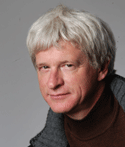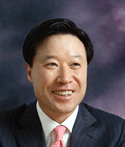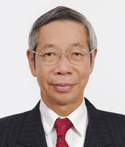Keynote Addresses
Opening & Keynote I: Tuesday, January 22, 8:30-10:00, Room 409

Jan Rabaey (Univ. of California, Berkeley, USA)
"A Brand New Wireless Day"
The wireless communications field has experienced a truly amazing growth since the early 1990's. Wireless connectivity slowly but surely has become pervasive. One would expect that by now this revolution must be losing some steam, but the truth is far from that. If anything, it is gathering even more speed. In the coming decades, introduction of innovative wireless technologies will enable a broad range of exciting applications to come to fruition, and reshape the way we interact with our daily living environment. Underlying it all is a three-tiered environment consisting of a large number of huge data and compute centers, billions of mobile compute and computation devices, and potentially trillions of tiny sensors and actuators.
Making this happen will require some important wireless roadblocks to be either overcome or circumvented. A short list of those includes spectrum scarcity, reliability, complexity, security and obviously power. In this presentation, a number of innovative and even revolutionary solutions to address these will be discussed. Examples are collaborative cognitive networks, wireless in the mm-wave region of the spectrum, and miniature wireless. Each of these approaches pushes some part of the design technology to its limits, and may even require a totally novel approach towards design, all this while semiconductor technology is trying to cope with the uncertainty of design in the nanometer regime.
One thing is for sure - the wireless designer of the next decade is bound for some very exciting times.
Keynote II: Wednesday, January 23, 9:00-10:00, Room 409

Ki-Soo Hwang (Core Logic, Korea)
"The Evolution of SoC Platform According to the New Mobile Paradigm"
Mobile business has grown rapidly over the last five years. With multimedia technology being applied quickly to the mobile environment, we are seeing a greater variety of mobile devices from mobile phones to MP3 players, cameras, and navigation devices, and as technology develops at a faster pace, truly innovating mobile multimedia technology is being witnessed. This innovative change can only be sustained upon a deep understanding of the evolution of SoC platforms according to the change in mobile paradigm.
In the early mobile phone market, call quality was the greatest issue. Afterwards as functions leveled off to a certain degree, manufacturers competed for better design in the aspects of high speed / stability, convergence, and slim form factors according to the introduction of the 2.5 generation mobile network in the early 2000s. At this stage, camera (photo), MP3 (music) and now even TV (video) functions have been converged into mobile phones giving momentum to the evolution of multimedia functions in mobile handsets. Until now the innovation of mobile handsets were centered around technology, but with 3G technology changing the focus from telephony to video telephony, the evolution of handsets is changing to the perspective of marketing and technology. In addition, with the emergence of the smart phone, not only is Internet easily accessible, but the wireless connection of mobile phones with other mobile devices has become important which is leading to a state of multi-networks.
As witnessed, the innovation of mobile handsets was led by faster development speed and convergence. In this kaleidoscope of handset development, SoC platform technology was at the foundation. The camera hefunction of mobile phones grew with the development of ASIC/SoC technology and the evolution of MPEG 2.4 technology which is the global standard for video multimedia. Now, the Multimedia Application Processor (MAP) which enables various multimedia applications such as music phone, movie phone, and TV (video) will evolve into a multimedia-centric Application Processor (AP) and will lead the transformation of multimedia along with other various operating systems.
In the new mobile environment which emphasizes Internet and connectivity, SoC technology and marketing will be the cornerstones of the mobile multimedia network and in order to efficiently support this we must understand the new mobile paradigm and evolve the SoC platform to accommodate this change.
Keynote III: Thursday, January 24, 9:00-10:00, Room 409

F. C. Tseng (TSMC, Taiwan)
"The Future of Semiconductor Industry - A Foundry's Perspective"
The semiconductor industry is in an extended period of moderate and steady growth. In this stage, many technologies are made to work together to deliver benefits that are greater than the sum of their individual parts. Economy of scale provides for steady cost reduction and constantly widening markets. The adoption of communication, computer and consumer products is spreading across the world in both advanced and developing economies. Opportunities are global and not concentrated on any one specific region. New applications and technologies now globally serve billions of people.
Meantime, the semiconductor industry is facing several economic, design and technology challenges. Solutions need to be developed in order to continue the industry growth. Foundry and IC companies must develop a much deeper and broader partnership. With end-to-end collaboration from design, wafer manufacturing to assembly and test, IC companies could fully leverage foundry's new technology offerings and capacity support in order to create the product differentiation in their end market. TSMC is committed to the long-term investment in leading edge technology development and GigaFab capacity expansion needed to enable the industry growth.
Last Updated on: October 22, 2007